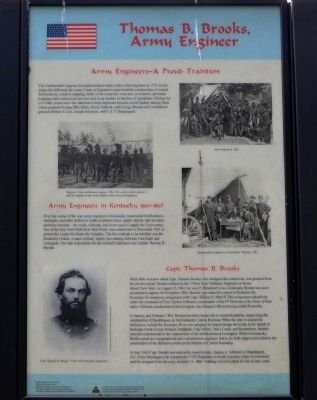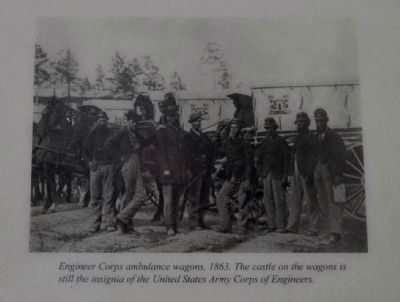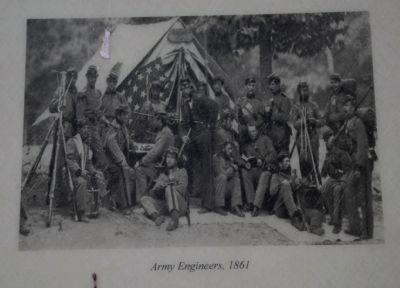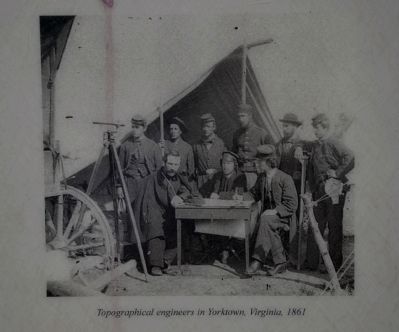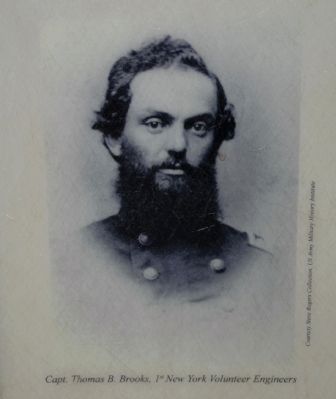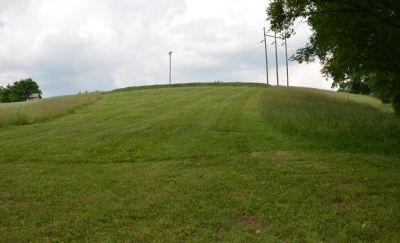Near Winchester in Clark County, Kentucky — The American South (East South Central)
Thomas B. Brooks, Army Engineer
Army Engineers - A Proud Tradition
The Continental Congress first authorized an army with a chief engineer in 1775. In the years that followed, the Army Corps of Engineers supervised the construction of coastal fortifications, aided in mapping much of the American West and, in wartime, provided mapping and construction services and troop leaders in theaters of operations. During the Civil War, many men who had been Corps engineers became noted leaders, among them Union generals George McClellan, Henry Halleck and George Meade and Confederate generals Robert E. Lee, Joseph Johnston, and P.G.T. Beauregard.
Army Engineers in Kentucky 1861-1865
Over the course of the war, army engineers in Kentucky constructed fortifications, stockades, and other defensive works to protect cities, supply depots, and the transportation network -- the roads, railroads, and rivers used to supply the Union army. One of the first, Fort Duffield in West Point, was constructed in November 1861 to protect the Louisville - Nashville Turnpike. The first railroad to be fortified was the Kentucky Central, a major military supply line running between Cincinnati and Lexington. The man responsible for the railroad's defenses was Captain Thomas B. Brooks.
Capt. Thomas B. Brooks
What little we know about Capt. Thomas Brooks, who designed this earthwork, was gleaned from his service record. Brooks enlisted in the 1st New York Volunteer Engineers at Staten Island, New York, on August 15, 1861; he was 25. Mustered in as a lieutenant, Brooks was soon promoted to captain. In November 1862, Brooks was ordered to report to Nicholasville, Kentucky for temporary assignment with Capt. William E. Merrill. This assignment placed him under the command of Gen. Quincy Gillmore, commander of the 2nd Division of the Army of Kentucky. Gillmore, headquartered in Lexington, was charged with protecting central Kentucky.
In January and February 1863, Brooks traveled extensively in central Kentucky, supervising the construction of blockhouses on the Kentucky Central Railroad. When his plan to extend the defenses to include the Kentucky River was adopted, he helped design the works at the mouth of Hickman Creek (Camp Nelson), Frankfort, Clay's Ferry, Tate's Creek, and Boonesboro. Brooks was also instrumental in the construction of the fortifications at Lexington. While in Kentucky, Brooks acted as a topographical and a construction engineer; that is, he both mapped and aided in the construction of the defensive works in the District of Central Kentucky.
In June 1863 Capt. Brooks was ordered to report to Gen. Quincy A. Gillmore in Washington, D.C. From Washington, he rejoined the 1st NY
Engineers in South Carolina, where he remained until he resigned from the army on April 15, 1864. Nothing is known about his life in later years.
Erected by The Winchester/Clark County Tourism Commission.
Topics. This historical marker is listed in these topic lists: Forts and Castles • War, US Civil. A significant historical month for this entry is February 1863.
Location. 37° 53.385′ N, 84° 15.553′ W. Marker is near Winchester, Kentucky, in Clark County. Marker can be reached from Ford Road (Kentucky Route 1924) 1.2 miles south of Boonesboro Road (Kentucky Route 627), on the left when traveling south. The exhibit can be reached from the parking area on KY Route 1924. The trailhead is at the edge of the parking area here. It is a 1/2 mile hike up the trail to the top of the hill where the fort is. Touch for map. Marker is at or near this postal address: 1250 Ford Road, Winchester KY 40391, United States of America. Touch for directions.
Other nearby markers. At least 8 other markers are within walking distance of this marker. A Defensive Strategy (here, next to this marker); An Unrealized Plan (here, next to this marker); Common Cliffside Plants (within shouting distance of this marker); Rock and Man (within shouting distance of this marker); Building the Earthwork (within shouting distance of this marker); The Eye of the Rich Land (within shouting distance of this marker); The Quest for Land (about 300 feet away, measured in a direct line); Inside the Earthwork (about 300 feet away). Touch for a list and map of all markers in Winchester.
More about this marker. This marker is part of the historic site known as the "Civil War Fort at Boonesboro." CAUTION: The climb up the hill is VERY steep. It involves a change in elevation of 230 feet. Not recommended for people that are not in good physical shape or condition.
Also see . . . Civil War Fort at Boonesboro. (Submitted on June 19, 2014.)
Credits. This page was last revised on June 16, 2016. It was originally submitted on June 19, 2014, by Karl Stelly of Gettysburg, Pennsylvania. This page has been viewed 769 times since then and 27 times this year. Photos: 1, 2, 3, 4, 5, 6. submitted on June 19, 2014, by Karl Stelly of Gettysburg, Pennsylvania. • Bernard Fisher was the editor who published this page.
